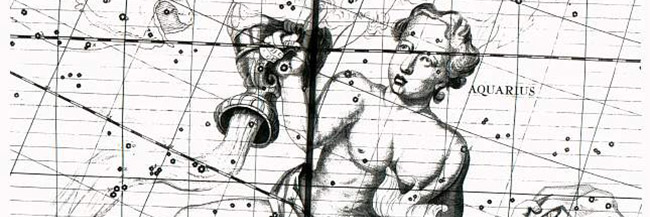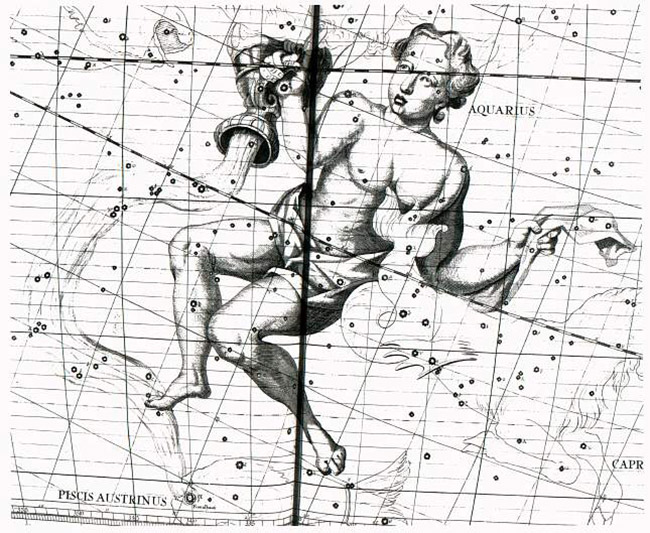Aquarius – Constellation Facts

Aquarius gets its name from Latin which means, water-bearer or cup-bearer and its Latin symbol also represents water. Aquarius was first catalogued in the 19th century by the Greek astronomer, Ptolemy. This unique constellation is the 10th largest and also represents a zodiac sign.
Constellation Characteristics
Aquarius can only be viewed in the fourth quadrant of the Southern hemisphere. It takes up 980 square degrees and is located specifically at latitudes between +65° and -90°. It also contains three Messiers, along with four meteor showers.

IAU and Sky & Telescope magazine (Roger Sinnott & Rick Fienberg), CC BY 3.0, via Wikimedia Commons
By IAU and Sky & Telescope magazine (Roger Sinnott & Rick Fienberg) CC BY 3.0, via Wikimedia CommonsPlanetary Systems
Aquarius is home to three galaxies known as Messiers. They were named after the astronomer who catalogued them, Charles Messier. It also has other notable deep space objects. Check them out.
- Messier 2 (M2, NGC 7089) was discovered in 1746 by Italian astronomer Jean-Dominique Maraldi. It is one of the largest global clusters known today containing about 150,000 stars. In addition, it is thought to be approximately 13 billion years-old.
- Messier 72 (M72, NGC 6981) is a global cluster located about 53,000 light-years away. It’s a relatively young cluster that contains mostly blue giant stars. It can be seen quite well through a 20-inch telescope.
- Messier 73 (M73, NGC 6994): although this asterium of four stars appear to be close together they are actually quite far apart and moving in different directions. It is around 2,500 light-years from Earth.
- Saturn Nebula (NGC 7009, Caldwell 55): this beautiful nebula emits strong ultraviolet radiation which is thought to give it its bright fluorescent green hue. In fact, through a large telescope it resembles the planet Saturn.
- Helix Nebula (NGC 7293, Caldwell 63): nicknamed ‘the Eye of God’ this nebula is about 700 light-years in distance and spans another 2.5 light years. It was first discovered in the 19th century by a German astronomer, Karl Ludwig Harding.
- The Aquarius Dwarf (PGC 65367, DDO 210): this galaxy is considered rare as it displays a blue-shift. It is only 3.1 million light-years in distance.
- Atoms for Peace Galaxy (NGC 7252): is thought to be the result of the collision of two disk galaxies that occurred approximately a billion years ago. It got its name from its unique appearance; a diagram of an electron orbiting the nucleus of an atom.
Main Stars
The constellation Aquarius contains many stars that make up its shape; however, they can be narrowed down to just six predominant stars.
- Sadalsuud (Beta Aquarii) is the brightest star in this constellation, which will be discussed in detail later.
- Sadalmelik (Alpha Aquarii) is from the Arabic phrase sa’d al-malik, which means “Luck of the King.” This star is classified as a yellow G-type supergiant and is located approximately 800 light-years away.
- Skat (Delta Aquarii) is the third brightest star in this constellation. It shares its name with Beta Pegasi (Scheat) which is derived from the Arabic as-saq, meaning leg or shin.
- Sadachbia (Gamma Aquarii) is a spectroscopic binary star that has a period of 58.1 days. Its name is Arabic for “luck of the homes or tents” (sa’d al-axbiyah).
- Sadaltager (Zeta Aquarii) is a binary star located in the “water jar” of this constellation. The brighter component of this star is a yellow-white F-type main sequence dwarf, while the lesser is a yellow-white F-type subgiant.
- R Aquarii is considered a symbiotic, binary star; a white dwarf and a red giant that is a Mira-type variable star.

Aquarius and his water jar, from the Atlas Coelestis of John Flamsteed (1729).
Most Shining Star
Out of all the stars that make up the Aquarius constellation, none shine brighter than Sadalsuud or Beta Aquarii. This star is a rare yellow supergiant and can be viewed at a 2.91 magnitude. It is located about 610 light-years away and has a mass 6 times our Sun. This star is also thought to bring luck after a long winter. In fact, its name in Arabic (sa’d al-suud) means “luck of lucks.”
Mythology & History
Aquarius is surrounded by a number of myths. The constellation represents a man pouring liquid from a water jar into the mouth of a fish. In Greek mythology, Aquarius is thought to have been associated with Ganymede – a handsome young man that caught the eye of Zeus. To capture Ganymede, Zeus disguised himself as an eagle and stole the youth away to serve as a cup-bearer to the gods. Egyptian legends has Aquarius representing the god of the Nile, while Babylonian mythology believe Aquarius was there to represent the god (Ea) himself.
Astrology
Aquarius is the eleventh sign of the zodiac. People born between January 20th and February 18th are Aquarians. Some characteristics of people born under this sign are;
- Original
- Witty
- Inventive
- Humanitarians
- Clever
People born under the Aquarius sign do tend to be a bit aloof, stubborn and very sarcastic at times. They do not like to be tied down and love the freedom and independence of their own desires. However, once you become friends with an Aquarius, they will be loyal and devoted, moving mountains to make people laugh and to feel good. Although Aquarius can be rebellious they do tend to be progressive thinkers that make good politicians and social workers.
Aquarius is a fascinating constellation, so the next time you are gazing into the night sky, be sure to search out this intriguing figuration of stars.
